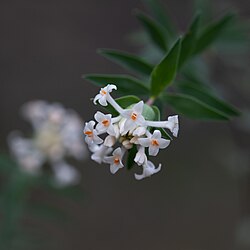Biology:Pimelea stricta
| Pimelea stricta | |
|---|---|

| |
| In the Sandy Creek Conservation Park | |
| Scientific classification | |
| Kingdom: | Plantae |
| Clade: | Tracheophytes |
| Clade: | Angiosperms |
| Clade: | Eudicots |
| Clade: | Rosids |
| Order: | Malvales |
| Family: | Thymelaeaceae |
| Genus: | Pimelea |
| Species: | P. stricta
|
| Binomial name | |
| Pimelea stricta Meisn.[1]
| |
| Synonyms[1] | |
| |
Pimelea stricta, commonly known as gaunt rice-flower,[2] is a species of flowering plant in the family Thymelaeaceae and is endemic to south-eastern continental Australia. It is an erect shrub with narrowly elliptic or linear leaves, and compact heads of densely hairy, creamy-white to yellow flowers surrounded by 4 egg-shaped involucral bracts.
Description
Pimelea stricta is an erect shrub that typically grows to a height of 0.5–1.5 m (1 ft 8 in–4 ft 11 in) and has glabrous stems. The leaves are arranged in opposite pairs and are narrowly elliptic or linear, 5–35 mm (0.20–1.38 in) long and 1.0–4.5 mm (0.039–0.177 in) wide on a short petiole. The flowers are bisexual and borne in compact clusters of many hairy, creamy-white to yellow flowers, surrounded by 4 egg-shaped involucral bracts 5–13 mm (0.20–0.51 in) and 3–9 mm (0.12–0.35 in) wide. The bracts are medium green, sometimes with a yellowish or reddish tinge. The floral tube is 7–12 mm (0.28–0.47 in) long, and the sepals are 2–4 mm (0.079–0.157 in) long. Flowering occurs in most months with a peak between August and November.[2][3][4][5]
Taxonomy
Pimelea stricta was first formally described in 1854 by Carl Meissner in the journal Linnaea from specimens collected in the Mount Lofty Ranges.[6] The specific epithet, (stricta) means "straight" or "upright".[7]
Distribution and habitat
Gaunt rice-flower mainly grows in open woodland, in mallee or on hills in sandy soils, and is found from north-eastern New South Wales through Victoria to the Eyre Peninsula and Flinders Ranges in south-eastern South Australia.[2][3][4][5]
References
- ↑ 1.0 1.1 "Pimelea stricta". Australian Plant Census. https://biodiversity.org.au/nsl/services/apc-format/display/70636.
- ↑ 2.0 2.1 2.2 Rye, Barbara L.. "Pimelea stricta". Flora of Australia. Australian Biological Resources Study, Department of Agriculture, Water and the Environment: Canberra. https://profiles.ala.org.au/opus/foa/profile/Pimelea%20stricta.
- ↑ 3.0 3.1 Harden, Gwen. "Pimelea stricta". Royal Botanic Garden Sydney. https://plantnet.rbgsyd.nsw.gov.au/cgi-bin/NSWfl.pl?page=nswfl&lvl=sp&name=Pimelea~stricta.
- ↑ 4.0 4.1 "Pimelea stricta". State Herbarium of South Australia. http://www.flora.sa.gov.au/cgi-bin/speciesfacts_display.cgi?form=speciesfacts&name=Pimelea_stricta.
- ↑ 5.0 5.1 Entwisle, Timothy J.; Walsh, Neville G.. "Pimelea stricta". Royal Botanic Gardens Victoria. https://vicflora.rbg.vic.gov.au/flora/taxon/28a18015-ca52-43cd-ad60-9cf1bdeabf51.
- ↑ "Pimelea stricta". APNI. https://id.biodiversity.org.au/instance/apni/481323.
- ↑ William T. Stearn (1992). Botanical Latin. History, grammar, syntax, terminology and vocabulary (4th ed.). Portland, Oregon: Timber Press. p. 506.
Wikidata ☰ Q17582277 entry
 |

